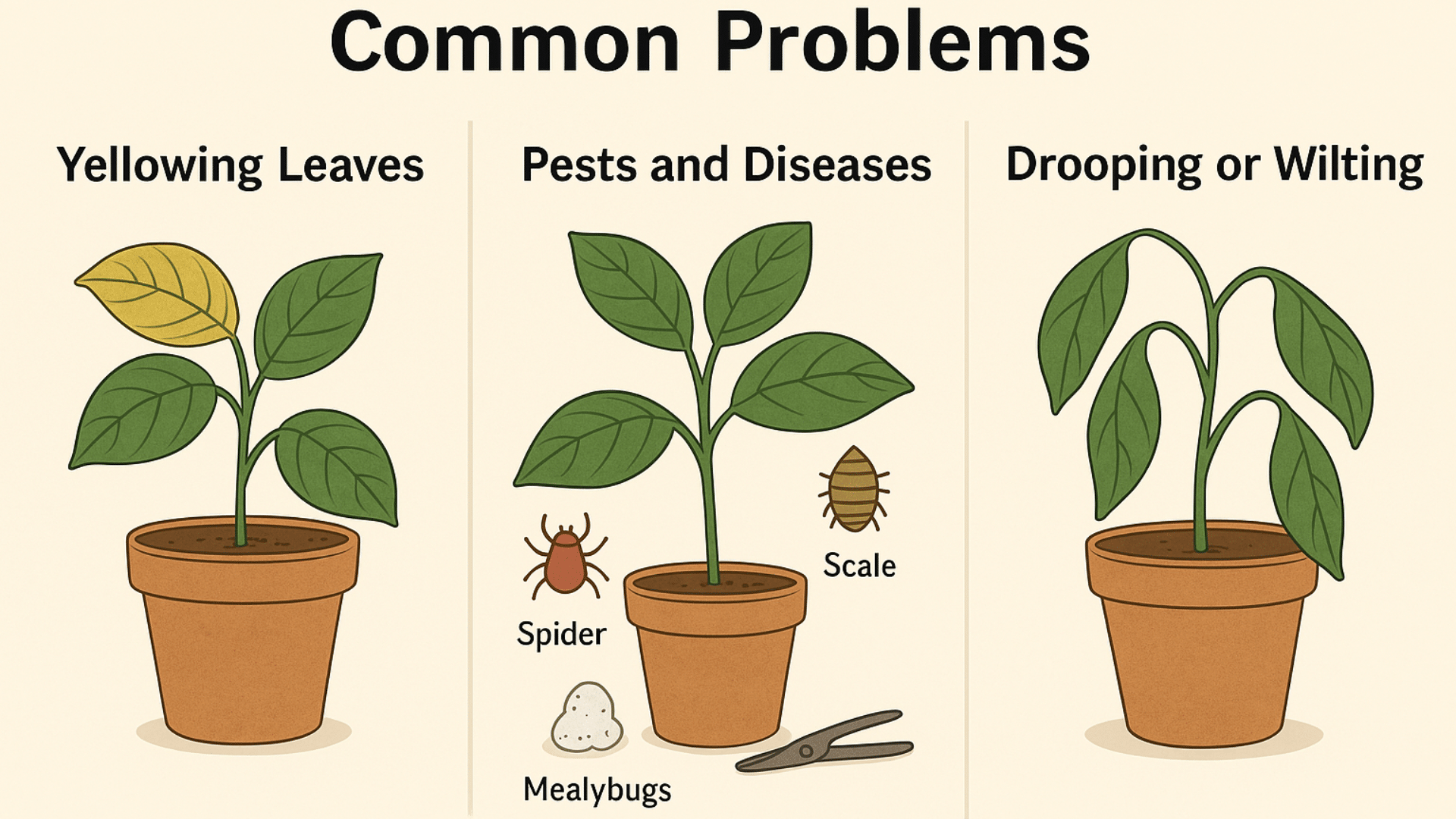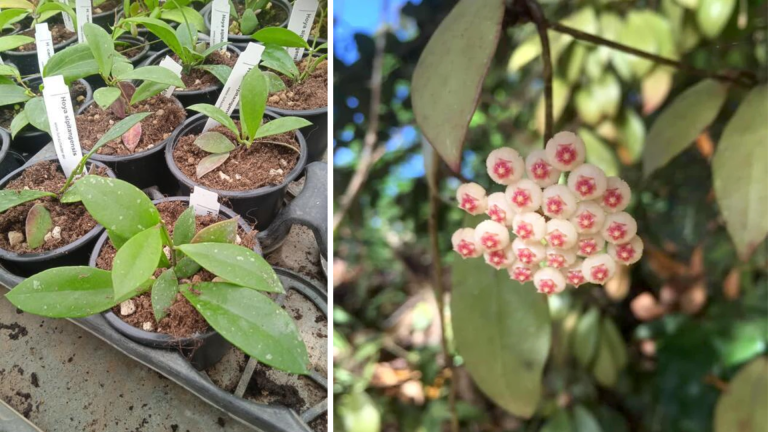I keep getting questions about Hoya sipitangensis, so let’s clear it up.
People want something different for their plant shelf, but they also don’t want a headache.
That’s where Hoya sipitangensis comes in. It looks great, handles indoor light, and doesn’t ask for much, as long as you give it the basics.
This post covers how to grow it, how to fix it when things go wrong, and how to make new ones from cuttings. You’ll also see how it compares to other Hoyas, so you know where it fits in your setup.
If you’re ready to add it or just want to stop guessing what it needs, keep reading. This guide spells it all out.
What is Hoya sipitangensis?
This one’s not your typical houseplant.
Hoya sipitangensis is a tropical vine with thick, green leaves that turn deep red in bright light. It also produces tight clusters of white flowers, each with a pink star-shaped center. The blooms give off a light, sweet scent—nothing overpowering.
It grows compact and doesn’t sprawl all over the place. That’s one reason collectors like it. The other? It looks good year-round if you give it the right conditions.
Origin and Habitat
This plant comes from the Sipitang region in Sabah, Malaysia, right on the island of Borneo.
It was first recorded in 2002. In the wild, it grows in warm, damp forests, often clinging to trees or rocks. It’s an epiphyte, which means it doesn’t need soil to grow, just moisture and something to hold onto.
Bright but indirect light and high humidity are what it’s used to. Keep those steady, and it’ll do just fine indoors.
Hoya sipitangensis vs. Other Hoyas
If you’re curious about how Hoya sipitangensis stacks up against other Hoyas, here’s a quick comparison to help you decide which one fits your space and care preferences.
| Feature | Hoya sipitangensis | Hoya Sunrise | Hoya Obscura | Hoya Brevialata |
| Leaf Color | Deep green, turns maroon/red in bright light | Green to reddish with sun-stress highlights | Dark green, turns red with light | Light green, round, and small |
| Leaf Shape | Small, thick, waxy | Lance-shaped | Oval, soft | Round, slightly fuzzy |
| Flower Appearance | White and fuzzy with a pink star center | Porcelain-like, pink to reddish | Cream blooms with red centers | Pale beige with yellow crown and red center |
| Fragrance | Light and sweet | Mild | Noticeable and pleasant | Sweet-scented |
| Growth Habit | Compact and slow-growing | Vining and fast | Climber with quick growth | Trailing, low-maintenance |
| Light Needs | Bright, indirect light is preferred | Can handle brighter light | Needs bright, filtered light | Tolerates medium to bright indirect light |
| Humidity Needs | High (60–80%) | Moderate to high | High humidity preferred | Moderate; adapts well |
| Ease of Care | Moderate | Easy to moderate | Moderate to high | Beginner-friendly |
Ideal Growing Conditions for Hoya sipitangensis
If you want this plant to stay healthy and keep growing, you’ve got to dial in the basics. That means proper light, steady temps, good humidity, and the right soil. None of it’s hard, but it all matters.
Light
Give it bright, indirect light. Near a window with a sheer curtain works well.
Morning sun is fine. Afternoon sun? Too much. It’ll scorch the leaves and leave brown spots.
If the leaves start turning dark red, that’s a sign your light is a little too strong. Back it off a bit.
Temperature and Humidity
Keep the temperature between 60–85°F.
This plant doesn’t like cold air or sudden changes. So skip the drafty windows and open doors in winter.
Humidity needs to stay high, somewhere between 60% and 80%.
Here’s how to keep it up:
- Use a small humidifier
- Set the pot on a pebble tray with water
- Mist it in the mornings
- Or group it with other plants
Soil and Fertilizer
Light, fast-draining soil is a must.
A good mix is orchid bark, perlite, and peat moss. Skip the heavy stuff; it’ll hold water too long and cause root rot.
In spring and summer, feed once a month. Use a balanced liquid fertilizer at half strength. Once the cold months roll in, stop feeding. There is no need to feed when it’s not growing.
Watering andCare Requirements
This plant doesn’t ask for much, but you’ve still got to give it the basics. Water it right and do some simple upkeep, and Hoya sipitangensis will hold up just fine for years.
Watering Tips
Let the soil dry out a bit between waterings.
It doesn’t want soggy roots, but don’t let it sit bone dry either. Here’s what to do:
- Water only when the top 1–2 inches of soil feel dry
- Use room temperature water; cold water can shock the roots
- Cut back on watering in fall and winter
- Yellow leaves? You’re watering too much
- Wrinkled or soft leaves? That’s a sign it needs water
And don’t forget to use a pot with a drainage hole. No plant wants its roots soaking in leftover water.
Pruning and Maintenance
You don’t need to trim it much. Just give it a little cleanup now and then.
- Snip off yellow or dead leaves with clean scissors
- Wipe dust off the leaves with a damp cloth
- Don’t cut the flower stalks. New blooms grow on the same ones
- Check for pests like mealybugs or spider mites every few weeks
Keep up with the basics, and you won’t have to deal with big problems later.
How to Propagate Hoya sipitangensis
Don’t want to buy another plant? Good. You don’t need to.
Hoya sipitangensis is easy to propagate, and if you follow the steps below, you’ll have new plants in no time.
- Cutting: Pick a healthy stem with 2–3 leaf nodes. Cut just below a node using clean scissors.
- Trimming: Remove the bottom leaves. Roots will grow from the bare node.
- Drying: Let the cutting sit out for 1–2 hours. That callus helps prevent rot.
- Watering: Set the cutting in a clean glass of water. Keep the node underwater, but don’t let the leaves touch it.
- Lighting: Place it in a warm spot with bright, indirect light.
- Refreshing: Change the water every 3–4 days to keep bacteria in check.
- Rooting: Wait 2–4 weeks for the roots to reach about 1–2 inches.
- Planting: Move it into well-draining soil and keep it lightly moist until you see new growth.
Once you see fresh leaves, you’re good to go. That plant’s ready to stand on its own
Where to Buy Hoya sipitangensis
If you’re in the U.S., here’s what you need to know before tracking one down.
- Retailers: Look on Etsy, Steve’s Leaves, Canopy Plant Co., and Plant Proper.
- Pricing: Small rooted plants start around $15. Mature ones can go as high as $90.
- Shipping: Most sellers charge $10–$17. Some include heat packs in colder months.
- Availability: This plant sells out fast. Restocks happen, but you’ve got to stay on it.
- Tips: Sign up for alerts. When it’s in stock, don’t wait, grab it.
Hoya sipitangensis isn’t always easy to find. But if you’re patient and ready to click fast, you’ll get one.
Common Problems with Hoya sipitangensis

Even if you’re doing everything right, things can still go sideways. The key is spotting problems early before they turn into real trouble.
Yellowing Leaves
This usually means you’ve got a watering problem.
Too much water leads to root rot. The leaves turn yellow and soft. Not enough light can also cause yellowing.
Here’s what to check:
- Feel the soil. If it’s wet and your pot doesn’t drain, that’s the issue
- Move the plant to a pot with drainage holes
- Let the soil dry out before watering again
- If it’s sitting in low light, move it to a brighter spot, but skip direct afternoon sun
Pests and Diseases
Watch for spider mites, mealybugs, and scale.
- Spider mites leave fine webs and tiny dots
- Mealybugs look like white fuzz in the leaf joints
- Scales are small, flat, and stick to the stems
Here’s how to deal with them:
- Wipe the leaves with soapy water
- For heavier cases, use neem oil once a week
Also, watch for root rot. If the stems go soft or leaves turn black. Cut off the damaged parts and repot in fresh, dry soil.
Drooping or Wilting
This is a water issue; either too much or not enough.
- If the soil is bone dry, water slowly until it drains out the bottom
- If it’s staying wet for days, check the drainage
- Use a chunkier mix that dries faster
Hoya sipitangensis bounces back quick when you catch the problem early. Stay on top of it, and you won’t have much to worry about
Wrapping Up
Hoya sipitangensis isn’t hard to grow. You just need to know what it wants.
By now, you’ve got the basics down. You know how to keep it healthy, fix common problems, and even grow new ones from cuttings.
So try something new. Adjust your care routine. Give a cutting to a friend. The more time you spend with this plant, the easier it gets.
Keep the light bright but soft. Water only when the soil’s dry. And let the plant do the rest.
If this helped you out, take a look at my other plant care guides. There’s always something new to learn.













